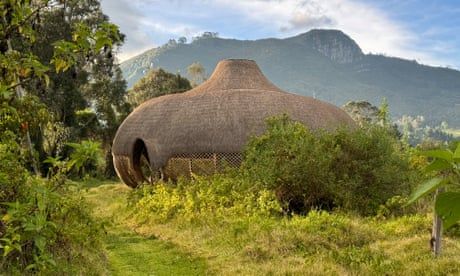
A 30-acre construction lab is helping reshape Colombia’s architecture with ancestral knowledge and direct ecological action. We head inside their smoking doughnut
A curious doughnut-shaped structure rises from an overgrown field on the outskirts of Tenjo, a rural town in central Colombia. It looks like a thatched UFO. Bamboo lattice walls curve up from the ground to form its bulging shell, tapering to a central chimney where wisps of smoke waft into the sky. Through the mesh walls, it is possible to make out bodies dancing in a circle around a fire, to the sound of drumming and chanting.
“As architects, we need to unlearn everything we have been taught,” says Ana María Gutiérrez, standing outside this momentous structure in muddy overalls, boots and a broad-brimmed black hat. “Our idea of progress is completely based on colonialist, extractivist practices. People talk about sustainability, but what exactly are we sustaining?”
The woven doughnut, Gutiérrez explains, is The House of Thought – an “intercultural temple” at the heart of her Centre for Regeneration. This is a 30-acre outdoor laboratory for indigenous construction techniques that she’s been building for 16 years. It is a place scattered with experiments, from structures that look like coil pots, to little domed houses built from sandbags. Some of the cavorting bodies inside the thatched temple belong to architects, who have come here for the day to cleanse themselves of their desk jobs, and get their hands dirty in workshops focusing on earth construction, ecological restoration, biodynamic agriculture and the healing properties of medicinal plants. Some are busy making bricks from troughs of mud.
Continue reading...